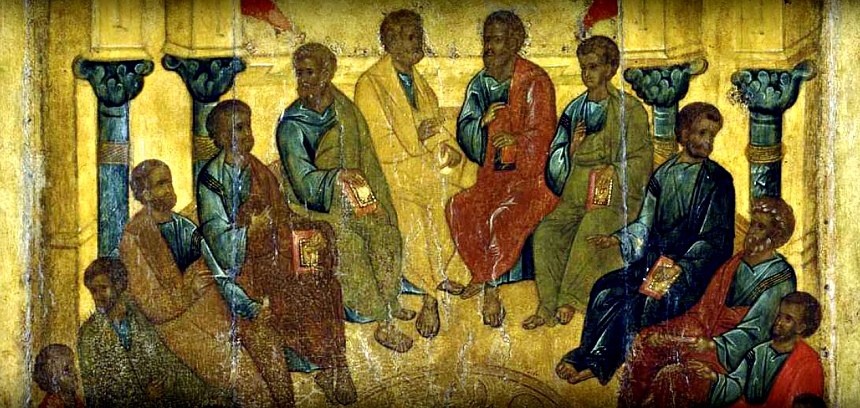Our Statement of Faith: The Nicene Creed

One must be very dubious of any church or ministry that puts their belief in the Bible above their belief in God. Yet, we see precisely this on many church websites under the statement of faith. For the Catholic Orthodox Christian, God is the object of our faith, first and foremost, and nothing supersedes this, as is clear in our statement of faith, the historic Nicene Creed.
The word creed comes from the Latin credo which means I believe. In the Catholic Orthodox Church the creed is usually called The Symbol of Faith which means literally the bringing together and the expression or confession of the faith. The Creed was formally drawn up by the Church back in 325 AD and 381 AD after great controversies developed in Christendom about the nature of the Son of God and the Holy Spirit. It is the Nicene-Constantinopolitan Creed, and is usually referred to simply as the Nicene Creed.
As the Symbol of Faith for Catholic Orthodox Christians, the Nicene-Constantinople Creed is recited by the faithful at every Divine Liturgy.
The Nicene Creed is a statement of the orthodox faith of the early Christian church in opposition to certain heresies, especially Arianism. These heresies, which disturbed the church during the fourth century, concerned the doctrine of the trinity and of the person of Christ. Both the Greek (Eastern) and the Latin (Western) church held this creed in honor, though with one important difference: early on about 589 A.D., parts of the the Western church insisted on including the phrase "and the Son" (known as the "filioque") into the article on the procession of the Holy Spirit. Later by the time of the great scisim in 1054 A.D., the Western Church had accepted the addition in most churches. This filioque phrase is srill repudiated by the Eastern Orthodox churches. In its present form this creed goes back partially to the Council of Nicea (A.D. 325) with additions by the Council of Constantinople (A.D. 381). It was accepted in its present form at the Council of Chalcedon in 451,
However, the creed is in substance an accurate and majestic formulation of the Nicene faith. This translation of the Greek text was approved by the CRC Synod of 1988.
The Nicene Creed
I believe in One God, (Deuteronomy 6:4; Mark 12:29, 12:32; Ephesians 4:6; 1 Corinthians 8:6)
The Father Almighty (Genesis 17:1-8; Exodus 6:3; Matthew 6:9; Ephesians 4:6; 2 Corinthians 6:18)
Maker of heaven and earth (Genesis 1:1; Job 38:1-30)
And of all things visible and invisible (Colossians 1:15-16; John 1:3; Hebrews 11:3; Revelation 4:11)
And in one Lord, Jesus Christ (John 20:28; Acts 11:17, 16:31; 1 Corinthians 8:6; Ephesians 4:5)
The Son of God, the Only-Begotten (Matthew 3:17, 14:33, 16:16; John 1:14, 3:16)
Begotten of the Father before all ages (Psalm 2:7; John 1:1-2)
Light of Light (John 1:4, 1:9, 8:12; Psalm 27:1; Matthew 17:2, 5; 2 Corinthians 4:6; Hebrews 1:3; 1 John 1:5)
True God of True God (John 1:1-2, 17:1-5; 1 John 5:20)
Begotten, not made (John 1:1-2, 16:28, 1:18)
Of one essence with the Father (John 10:30)
By Whom all things were made (Hebrews 1:1-2, 10; John 1:3, 1:10; Colossians 1:16; 1 Corinthians 8:6; Romans 11:36)
Who for us men and for our salvation (I Timothy 2:4-5; Matthew 1:21; 1 Thessalonians 5:9; Colossians 1:13-14)
Came down from heaven (John 3:13, 3:31, 6:33-35, 38)
And was incarnate of the Holy Spirit and the Virgin Mary (Luke 1:34-35)
And became man (John 1:14; Hebrews 2:14)
And He was crucified for us (Mark 15:25; I Corinthians 15:3; 1 Peter 2:24)
under Pontius Pilate (Mark 15:15)
And suffered (Mark 8: 31; Matthew 27:50)
And was buried (Luke 23:53; 1 Corinthians 15:4; Matthew 27:59-60)
And He rose again on the third day (Mark 9:31, 16:9; Acts 10:40; 1 Corinthians 15:4)
According to the Scriptures (Luke 24:1, 45-46; 1 Corinthians 15:3-4)
And ascended into heaven (Luke 24:51; Acts 1:9-10; Mark 16:19)
And sits at the right hand of the Father (Mark 16:19; Acts 7:55; Luke 22:69)
And He will come again with glory (Matthew 24:27; Mark 13:26; John 14:3; 1 Thessalonians 4:17)
To judge the living and the dead (Acts 10:42; 2 Timothy 4:1; Matthew 16:27; 2 Corinthians 5:10; 1 Peter 4:5)
His kingdom shall have no end (2 Peter 1:11; Hebrews 1:8)
And I believe in the Holy Spirit (John 14:26; Acts 1:8)
The Lord and Giver of life (Acts 5: 3-4; Genesis 1:2; John 6:63; 2 Corinthians 3:6)
Who proceeds from the Father (John 15:26)
Who together with the Father and the Son is worshipped and glorified (Matthew 3:16-17)
Who spoke through the prophets (I Samuel 19:20; Ezekiel 11:5; 1 Peter 1:10-11; Ephesians 3:5)
And I believe in one, holy, catholic and apostolic Church (Matthew 16:18, 28:19; 1 Peter 2:5,9; Ephesians 1:4, 2:19-22, 4:4, 5:27; Acts 1:8, 2:42; Mark 16:15; Romans 12:4-5; 1 Corinthians 10:17)
I acknowledge one baptism for the remission of sins (Ephesians 4:5; Galatians 3:27; 1 Corinthians 12:13; Colossians 2:12-13; Acts 22:16)
I look for the resurrection of the dead (John 11:24; 1 Corinthians 15:12-49; Romans 6:4-5; 1 Thessalonians 4:16)
And the life of the world to come. (Mark 10:29-30; 2 Peter 3:13; Revelation 21:1)
Amen. (Psalm 106:48)
"May God Bless You!"

